Hey guys, noob here. I'm not sure how to interpret these results. I've been trying to get WinISD to run on my Mac but I've been trying various forms of Wine for days and am starting to give up D:
I'm aware this driver has weak excursion but I wanna run it through the gauntlet before upgrading. Is it correct that that Max Power Input of my whole mechanical system is 40W? So I don't need an amp for more than 50W or so? I've seen recommended box designs from the manufacturer for more than 250W... and how should I adjust Nominal Power
I'd appreciate any input here

I'm aware this driver has weak excursion but I wanna run it through the gauntlet before upgrading. Is it correct that that Max Power Input of my whole mechanical system is 40W? So I don't need an amp for more than 50W or so? I've seen recommended box designs from the manufacturer for more than 250W... and how should I adjust Nominal Power
I'd appreciate any input here
Hi, entered data for modelling. Assuming I didn't mess up!
In the following graph, xmax is actually 2.4 and not 4.8, I edited it.

Following dimensions recommended by parts express.
About 25 W for with 85 Lt closed box. Blue line.

P.E. staff suggested a 50Hz high-pass for a ported box, you might want to check the QA. I had some graphs but I removed them, it's better if you model the ported version. You can model the filters in WinISD. Or go closed...
Also, the amp needs headroom. It's a 8 ohm driver, so take this into account. Hopefully somebody else will give you a tip for the required power.
In the following graph, xmax is actually 2.4 and not 4.8, I edited it.
Following dimensions recommended by parts express.
About 25 W for with 85 Lt closed box. Blue line.
P.E. staff suggested a 50Hz high-pass for a ported box, you might want to check the QA. I had some graphs but I removed them, it's better if you model the ported version. You can model the filters in WinISD. Or go closed...
Also, the amp needs headroom. It's a 8 ohm driver, so take this into account. Hopefully somebody else will give you a tip for the required power.
Last edited:
I just noticed the suggested dimensions in the graph you posted, so the xmax is 4.8 after all. So, correcting.
40W for the closed box in your data and 90W for the 86Lt by P.E.
First time I read "xmax peak" in a spec, I wrongly assumed it was 2*xmax.
Excursion:

SPL, like in your graph.

40W for the closed box in your data and 90W for the 86Lt by P.E.
First time I read "xmax peak" in a spec, I wrongly assumed it was 2*xmax.
Excursion:
SPL, like in your graph.
Generally speaking (almost) any speaker will reach xmax with low input power at some low frequency. But music usually does not contain much below 40 hz (different with movie soundtracks).Is it correct that that Max Power Input of my whole mechanical system is 40W?
Also, it is usually no problem for a good driver to reach xmax, it will just gradually produce more distortion. Once you overload it to reach xmech or xdamage, that's obviously too much. But you will lower the volume long before that happens. Just take care with unexpected switching or un/plugging thumps.
Thermal limit on the other hand can exactly be defined.
So it mainly depends whether your music signal contains frequencies (and will be played so loud) that may overload your driver in the cabinet.
Also keepin mind that your driver with 96 dB efficiency will be incredibly loud with anything around 50 watts.
I just simulated your speaker with hornresp as closed box with 204 litres and alternatively as vented box with 450 litres (huge!),
the graph shows the response and the maximum SPL.
red line indicates excursion limit, black line is thermal limit.
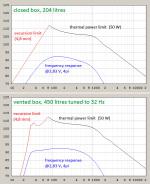
in addition to the above here is a link to a post with a graph that shows maximum peaks of some different music tracks.
as you can see it greatly depends on your music preference whether you will have peaks in the lower frequency range or not and whether with your speaker and your desired SPL level you will reach thermal or xmax limits.
the graph shows the response and the maximum SPL.
red line indicates excursion limit, black line is thermal limit.

in addition to the above here is a link to a post with a graph that shows maximum peaks of some different music tracks.
as you can see it greatly depends on your music preference whether you will have peaks in the lower frequency range or not and whether with your speaker and your desired SPL level you will reach thermal or xmax limits.
Eminence have some cabinet design plans for the Delta 15LFA on their website, they show you some power handling/cone excursion graphs using different sized cabinet volumes/tunings.
https://cdn.shopify.com/s/files/1/0270/8665/1462/files/Delta_15LFA_cab.pdf
https://cdn.shopify.com/s/files/1/0270/8665/1462/files/Delta_15LFA_cab.pdf
Basic Reflex cabinet unloads below port frequency.
Which is why power limit is less than thermal.
The Eminence Design guides showing more power
being used closer to the thermal limit.
Is Mid Bass Application, Using a High Pass filter.
Good points is realistic " program" material
goes down to about 35 to 40 Hz
So usually just apply power till you reach Xmax at 35 Hz
Or for transients 1 or 2mm above Xmax.
In a home situation SPL is already 96 dB
Actually lower in full space.
But basically wont need more than 1 to 7 watts
To reach high levels.
Keeping tuning lower will have more cone control
down low, and using a Over excursion 4th order highpass
few Hz below tune frequency. Will Help too
applying power and viewing a cone excursion graph
make the behavior of a reflex more understandable.
Including where the cone stops moving when the reflex
starts working. Its basically where response starts to have no
accuracy. And unloading below Fb ( tuning) visible
Which is why power limit is less than thermal.
The Eminence Design guides showing more power
being used closer to the thermal limit.
Is Mid Bass Application, Using a High Pass filter.
Good points is realistic " program" material
goes down to about 35 to 40 Hz
So usually just apply power till you reach Xmax at 35 Hz
Or for transients 1 or 2mm above Xmax.
In a home situation SPL is already 96 dB
Actually lower in full space.
But basically wont need more than 1 to 7 watts
To reach high levels.
Keeping tuning lower will have more cone control
down low, and using a Over excursion 4th order highpass
few Hz below tune frequency. Will Help too
applying power and viewing a cone excursion graph
make the behavior of a reflex more understandable.
Including where the cone stops moving when the reflex
starts working. Its basically where response starts to have no
accuracy. And unloading below Fb ( tuning) visible
In a home situation SPL is already 96 dB
Actually lower in full space.
But basically wont need more than 1 to 7 watts
To reach high levels.
Yup, I think the question is now about how big your room is and how loud you want it to play. Closed is easier, ported you can get more low freq response but also have to think about more stuff.
I wouldn't make it ported unless I can live with a big box and I wouldn't need more than a few watts. But that's me.
LFA is more specific a Mid Bass driver or for sealed application like a monitor.
So if you observe the behavior in a model you will see that the difference
between sealed and vented is very little.
Qts seems around normal .48 so you would not expect it to behave like a high Qts driver.
Once in a model it does behave more like a high Qts driver
Seems they played around more with the mechanical properties
and the extremely large Vas kinda makes it all make sense.
For a auto alignment program it would have a hard time, or be almost impossible
to get a QB3 alignment
If you put it in 3 to 3.8 cubic feet that is about the deepest extension you will get.
Reflex wont go much lower and just unload.
It is really more designed as a high Q mid bass in a sealed application.
So if you observe the behavior in a model you will see that the difference
between sealed and vented is very little.
Qts seems around normal .48 so you would not expect it to behave like a high Qts driver.
Once in a model it does behave more like a high Qts driver
Seems they played around more with the mechanical properties
and the extremely large Vas kinda makes it all make sense.
For a auto alignment program it would have a hard time, or be almost impossible
to get a QB3 alignment
If you put it in 3 to 3.8 cubic feet that is about the deepest extension you will get.
Reflex wont go much lower and just unload.
It is really more designed as a high Q mid bass in a sealed application.
Where are you getting this number, and is it something I can replicate with Unibox? Are you saying I'd get best performance with a ~50W amp and roughly that size closed box?If you put it in 3 to 3.8 cubic feet that is about the deepest extension you will get.
Reflex wont go much lower and just unload.
What are you aiming to achieve with the driver and box, for what usage?
I have spent time playing with sims for the 12LFA, pretty sure its the same motor in a bigger frame, and found it's difficult to push reflex response much lower than 50Hz - sealed with DSP might work for you, all depends on goals/expectations
I have spent time playing with sims for the 12LFA, pretty sure its the same motor in a bigger frame, and found it's difficult to push reflex response much lower than 50Hz - sealed with DSP might work for you, all depends on goals/expectations
I either entered the data into my WinIsd or have the old copy of it from the database.
That driver has been around for many years.
Basically would have the same question, is this a high efficiency system for home use
or a stage amp.
For home use, yes pretty standard receiver with 30 to 50 watts a channel
work fine with high efficiency systems.
I have run 2x15 plus horn and also 18" bins in the house.
And the kids minds get blown when the windows rattle with everyday
amplifiers.
That driver has been around for many years.
Basically would have the same question, is this a high efficiency system for home use
or a stage amp.
For home use, yes pretty standard receiver with 30 to 50 watts a channel
work fine with high efficiency systems.
I have run 2x15 plus horn and also 18" bins in the house.
And the kids minds get blown when the windows rattle with everyday
amplifiers.
Last edited:
Checked my data
It is the fun thing about WinIsd is it has been around for awhile
and had a large library.
I Have Data from 2004 for the Delta 15 LFA
I will use new Data from Eminence as well
And give you a breakdown of how it behaves in Sealed application.
then find a possible feasible reflex.
As mentioned Q is high so Standard Alignments
Or common Online calculators would give confusing suggestions.
Unless there is any significant change from 2004
It is the fun thing about WinIsd is it has been around for awhile
and had a large library.
I Have Data from 2004 for the Delta 15 LFA
I will use new Data from Eminence as well
And give you a breakdown of how it behaves in Sealed application.
then find a possible feasible reflex.
As mentioned Q is high so Standard Alignments
Or common Online calculators would give confusing suggestions.
Unless there is any significant change from 2004
Ridiculous to Quote myselfI will use new Data from Eminence as well
And give you a breakdown of how it behaves in Sealed application.
But here yah Go
Shows Needed Volume for Driver Q or Qtc for =
.7
.8
.9
1.00
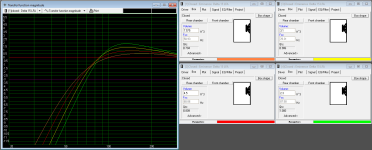
Basically Something realistic around .8 to .9 Qtc
Is the good old 3 to 4 cubic feet for a 15" live sound driver.
Nice to have multiple projects open so Q
and what the heck it is makes sense visually
Now lets answer the question " How much power does it Handle"
Xmax= 4.8 mm
Considered how far the speaker can move till it reaches
Max linear distortion = 10% distortion
Xlim = 16.5 mm
Considered how far the speaker can move before physical
damage. Usually when the coil will eventually smack the rear plate
rearward, or crease or damage the surround forward.
This is for sealed application
Both projects .9 Qtc in 3 cubic feet.
100 watts Linear
if 500 watts max thermal power applied
under physical damage
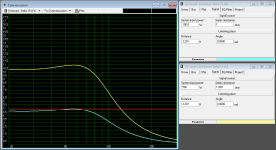
Sealed application
Both projects .8 Qtc 4.5 cubic feet
65 watts Linear
500 watts max thermal applied
under physical damage
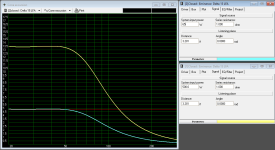
Approximate SPL @ 65 and 100 watts
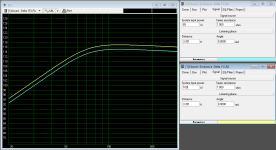
Nobody runs at full thermal power. That is insanity
And debatably when it would die in real life.
Really spongy, farting distortion for musician about
15% distortion. Be a dynamic burst around 130 to 150 watts.
Far as I remember for " Thermal Rating" of 500 watts
Usually a 2 hours test and is when the driver is actually destroyed.
Xmax= 4.8 mm
Considered how far the speaker can move till it reaches
Max linear distortion = 10% distortion
Xlim = 16.5 mm
Considered how far the speaker can move before physical
damage. Usually when the coil will eventually smack the rear plate
rearward, or crease or damage the surround forward.
This is for sealed application
Both projects .9 Qtc in 3 cubic feet.
100 watts Linear
if 500 watts max thermal power applied
under physical damage

Sealed application
Both projects .8 Qtc 4.5 cubic feet
65 watts Linear
500 watts max thermal applied
under physical damage

Approximate SPL @ 65 and 100 watts

Nobody runs at full thermal power. That is insanity
And debatably when it would die in real life.
Really spongy, farting distortion for musician about
15% distortion. Be a dynamic burst around 130 to 150 watts.
Far as I remember for " Thermal Rating" of 500 watts
Usually a 2 hours test and is when the driver is actually destroyed.
Last edited:
As mentioned the driver mainly designed for sealed.
What about Vented ?
Has high Q so Auto Alignment or a standard QB3 or SB4
With a Sim or online calculator wont do it.
It is gonna try and use 10 to 14 cubic feet and port tuning
wont be defined. Its a tricky one, Some live sound drivers
Do that.
what do you do.
Take what we learned from sealed Qtc and apply rule of thumbs
for tuning. Usually no more than 5 to 7 Hz above or below
free air resonance or Fs = 39 Hz
So we make a big blob using .8 and .9 Qtc 3 cubic feet and 4.5 cubic feet.
And tune 7 hz below 7 hz above and see what cha get.
Then toss in something in the Middle which is the bold pink lines
3.8 ft^3 sealed 3.8ft^3 vented about .850 Qtc
As you see Q goes to high and low but overall F3 about the same.
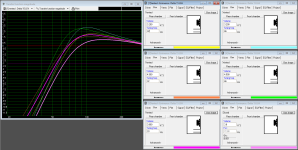
For clarity .8 to .9 Qtc sealed .850 vented
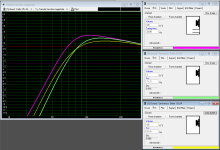
Cone Excursion 3.8 cubic feet Sealed and Vented 33 Hz Fb
100 watt Vented, 80 watt Sealed
But notice Vented Unloads below tuning. Less cone control
Big Dynamic peaks would risk Xlim.
Cure = Over Excursion Filter Highpass 4th order Butterworth 30 Hz
Yellow Line.
Max SPL same old 115 to 118 dB sealed or vented.
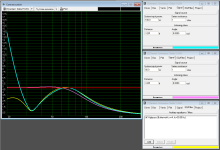
What about Vented ?
Has high Q so Auto Alignment or a standard QB3 or SB4
With a Sim or online calculator wont do it.
It is gonna try and use 10 to 14 cubic feet and port tuning
wont be defined. Its a tricky one, Some live sound drivers
Do that.
what do you do.
Take what we learned from sealed Qtc and apply rule of thumbs
for tuning. Usually no more than 5 to 7 Hz above or below
free air resonance or Fs = 39 Hz
So we make a big blob using .8 and .9 Qtc 3 cubic feet and 4.5 cubic feet.
And tune 7 hz below 7 hz above and see what cha get.
Then toss in something in the Middle which is the bold pink lines
3.8 ft^3 sealed 3.8ft^3 vented about .850 Qtc
As you see Q goes to high and low but overall F3 about the same.

For clarity .8 to .9 Qtc sealed .850 vented

Cone Excursion 3.8 cubic feet Sealed and Vented 33 Hz Fb
100 watt Vented, 80 watt Sealed
But notice Vented Unloads below tuning. Less cone control
Big Dynamic peaks would risk Xlim.
Cure = Over Excursion Filter Highpass 4th order Butterworth 30 Hz
Yellow Line.
Max SPL same old 115 to 118 dB sealed or vented.

OK. I’m planning to stay sealed for simplicity, for now. Why do you think the manufacturer suggests a sealed enclosure vol. of only 1.3-1.5 ft^3? If 4.5 ft^3 and ~100 W for some overhead will give me some decent bass extension, ima go with that.Sealed application
Both projects .8 Qtc 4.5 cubic feet
65 watts Linear
Thanks for all the help, y’all.
It's a prosound driver, so for a prosound app = max power handling alignment and EQ to suit the specific app.
What do you mean?It's a prosound driver, so for a prosound app = max power handling alignment and EQ to suit the specific app.
- Home
- Loudspeakers
- Subwoofers
- how much power can my driver handle?